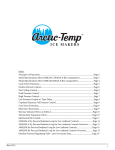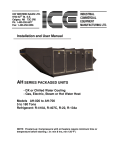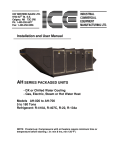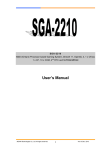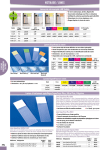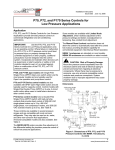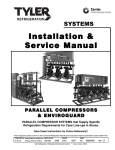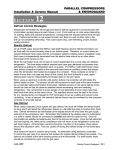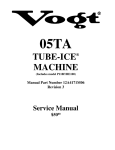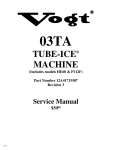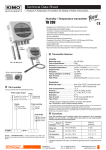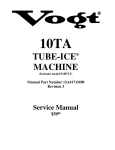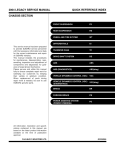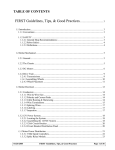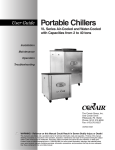Download Pre-Start Inspection Document
Transcript
PRE-START INSPECTION DOCUMENT Refrigerant loss on start-up due to broken capillaries, refrigerant lines, and other parts and components damaged in transit by vibration are not subject to reimbursement. The refrigerant charge is contained in the receiver and the valves should not be opened until a pre-start inspection determines all line and capillaries are intact. Inspect exterior of machine and skid for any signs of shipping damage. Remove the front panels and top cover of the ice machine along with the condensing unit top. Perform a visual inspection of all lines, tubing, and components to determine that transit vibration has not caused damage or breakage. Loosen black knobs securing evaporator panels in order to remove the cardboard dunnage (packing) securing the evaporator tube. The evaporator tubes should be parallel and plum. If necessary, align by using hand pressure only. Note: Oil spots on components, lines, and equipment may indicate a control or refrigerant line has ruptured in transit. Any visible signs of oil leaks should be reported to the technician or mechanic prior to opening the refrigerant valves. Opening valves and letting refrigerant escape by mistake or error is not a warranty issue. Refrigerant loss and service valve replacement due to failure to properly open and close packing glands on service valves is not covered under warranty WARNING: All service and ball valves must be open prior to starting the machine. Failure to open the compressor service valves may result in severe personal injury or death when the compressor explodes. These valves must be opened by a qualified mechanic or contractor. TECHNICAL SERVICE If you have any questions regarding the installation or operation of our equipment, please call for technical assistance before proceeding. (800) 362-3243 WARRANTY REGISTRATION Effective January 1, 2007 we are asking customers to register their machine serial numbers and start-up dates by return card in order to track and process warranty claims for machines sold to Ice House America. MACHINE STARTING Machine starting, testing, and monitoring system performance at start-up should involve a qualified refrigeration technician. At start-up, the machine should be checked thoroughly to confirm that all operating pressures and control set points are correct. The start-up process is outlined below for the mechanic and further explained in our service manuals supplied with each machine. CONDENSED INFORMATION FOR REFRIGERATION TECHNICIAN ELECTRICAL INSTALLATION Prior to installing electrical service to the machine, the electrician should perform a cursory inspection of the condensing unit electrical panel to confirm that the wiring and controls have not become loosened in transportation. He should be instructed to inspect and confirm that the contactor leads and exits on both the L and T sides of the contactor are secured and tight to all fuses, blocks, and attendant circuits. A loose lead on the L or T sides of the contactor will likely cause electrical damage that may result in a compressor failure. Therefore, it is important the stress the necessity of this brief inspection before the power service has been installed to the machine. MAKE-UP WATER INSTALLATION The compressor bulkhead that supplies water to the sump assembly accepts 3/8” OD copper tubing. If PVC tubing is used for any portion of the water supply run, it is imperative to keep PVC debris and Teflon tape from entering the water line. The smallest debris will block the float valve resulting in a removal and replacement of the water supply float valve. After the water service has been installed, the float valve should maintain a water level that is 2 ½ inches deep. OPENING SERVICE VALVES Prior to opening the service valves, the machine OFF/ON/PUMP should be in the off position. After the power disconnect has been energized and voltage to the contactor has been confirmed, the machines service valves can be opened. The MODEL 5200LSM has five (5) service valves that must be opened prior to starting. Models equipped with a Pressure Regulating Valve (Low Ambient Control) have a sixth (6 th) valve that must be opened. 1) 2) 3) 4) 5) 6) Suction Service Valve Discharge Service Valve Receiver Outlet Valve Liquid Line Valve at base of condensing unit Hot Gas Ball Valve Ball Valve on Hot Gas Loop (Additional for Low Ambient Control) The MODEL 1000LSM has six (6) service valves that must be opened prior to starting. Models equipped with a Pressure Regulating Valve (Low Ambient Control) have a seventh (7th) valve that must be opened. 1) 2) 3) 4) 5) 6) 7) Suction Service Valve Discharge Service Valve Receiver Outlet Valve Receiver Inlet Valve Liquid Line Valve at base of condensing unit Hot Gas Ball Valve Ball Valve on Hot Gas Loop (Additional for Low Ambient Control) CONDENSED INFORMATION FOR REFRIGERATION TECHNICIAN When opening the service valves, please be advised of the following: Refrigeration ball valves do not have a packing gland and are full opened by turning the stem 90 degrees to the opposite stop. Standard refrigeration service valves may or may not containing a packing gland. Service valves that are supplied with a packing gland require that the packing gland be loosened before opening (back seating). Once the valve is fully “back seated” and open, the packing gland must be re-tightened to prevent refrigerant loss from the packing gland. CAUTION: If any refrigerant line or control leaks are noticed during the opening of the valves, all open valves should be closed immediately in order to prevent refrigerant loss. STARTING DELAY OF TWO HOURS With electrical power energized, and the service valves open, the machine should not be started for two hours. The two hour delay is required to allow the crankcase heater to warm the oil and prevent refrigerant migration into the oil sump. Excessive refrigerant in the compressor sump will displace the oil and the oil pump will attempt to pump liquid refrigerant which could cause an immediate compressor failure. Please See Crankcase Heater narrative in controls section. STARTING OF MACHINE When the machine is started, it will take several cycles for the make-up water to chill and for the machine to stabilize. The evaporators should be making ice almost to the bottom of the external and internal water distributors with a “scalloping effect” at the top. At that point, the control settings and operating ranges should be confirmed by the mechanic with gauges. Each ice machine is shipped with a control setting label affixed to the rear side of the machine that contains the proper PSIG settings for the controls and switches. These settings and operations must be physically confirmed by the mechanic to insure the machine is operating properly. A further explanation of the specific controls and their functions are listed below. . MACHINE CONTROL OPERATION CYCLE TIMER: Arctic-Temp ice makers use a direct drive repeating cycle timer with a single cam to control freeze and harvest cycles. The cycle timer cam allows for a total rotation time of eight (8) minutes with a portion (the indented segment of the cam) allocated for harvest (removal of ice) The FREEZE CYCLE is ninety-percent of the total cycle. During this cycle, the compressor and water pump operate with the hot gas solenoid valves closed and the ice crusher motor de-energized. At the end of the freeze cycle, the roller on the micro switch enters the cam detent and initiates the harvest cycle. The HARVEST CYCLE is ten-percent of the total cycle. During this cycle, the compressor continues to operate, the water pump is de-energized, and the hot gas solenoid valves and crusher motor are energized. During the harvest cycle, the “ice bond” to the evaporator is broken by hot gas and the ice is removed from the evaporator by gravity. NOTE 1) Most timer problems are attributable to misaligned Microswitch roller guides that are not centered on the edge of the cam. Misalignment is generally due to loose mounting screws or manual adjustment of the switch arm by pliers. NOTE 2) If the timer motor cam does not turn during the FREEZE CYCLE, the timer or the 240 volts switching relay is defective. POSITIVE HARVEST CONTROL: PENN P70CA-1 Positive harvest is controlled with a reverse acting low pressure control, switching relay, and red pilot light. This control works in conjunction with the timer to ensure hot gas is provided to the ice making evaporators to assist harvest in lower ambient temperatures or over condensing cause by excessive wind on the coil. When the machine enters harvest, the low pressure control and relay de-energize the timer motor and allow additional harvest time until the suction pressure reaches a specific set which will allow the timer to resume rotation. NOTE 1) When the red pilot light is illuminated, the timer motor is locked out of the circuit and timer rotation is stopped. Note: Low ambient conditions that cause the machine to continue to operate in harvest may result in compressor failure. NOTE 2) Condenser fans must be off during the harvest cycle to avoid freeze-ups and other control failure trips. SINGLE HIGH PRESSURE CONTROL: PENN P70DA-2 The Model 1000LSM uses a stand-alone high pressure switch that provides the same function and operation of the high safety operation control identified above. A trip of this switch easily identifies that the condition that caused the trip was high pressure. SINGLE LOW-PRESSURE CONTROL, PENN P29NC-3 with Time Delay The Model 1000LSM uses this control which aids in low ambient starting conditions by providing a 60 second time delay to avoid low pressure trips when starting in cold weather. In low ambient conditions, the head pressure will not force enough refrigerant through the expansion valves to elevate the suction pressure. As a result, a control trip occurs because the safety point cut-out on the low side is exceeded. The time delay on this control will aid in the reduction of “nuisance” trips by providing the machine 60 additional seconds to build the necessary operating pressures above the set point. This control must be set and checked with a volt meter connected to switch terminals # 1 & 2 on the control. As the suction pressure drops, the meter reading will drop to zero volts at the set point. The delay will then be activated allowing the machine to run for and additional 60 seconds. If the suction pressure remains below the set point for more than 60 seconds, the machine will shut down. NOTE The intended benefit of this control is often negated by the failure to set this control correctly. FAN CONTROLS: PENN P70AA-118 Penn fan cycling controls are used to regulate head pressure by cycling the condenser fans motors. These switches are used to cycle the fan motors on and off at a specific setting. The Models 5200LSM and Models 1000LSM operate with dual fan cycling controls that are staged. NOTE Condenser fans that are operating during the harvest cycle is a clear indication that the fan controls are set incorrectly. CRANKCASE HEATER Crankcase heaters are used to keep the oil warm during off cycles to prevent refrigerant migration into the oil sump. If refrigerant mixes with oil during the off cycle, the oil will be pumped out of the crankcase along with the refrigerant resulting in diminished lubrication for the compressor and can cause damage to the rods and crankshafts resulting in compressor failure. Excessive refrigerant in the compressor sump will displace the oil and the oil pump will attempt to pump liquid refrigerant. When this occurs, the liquid refrigerant “flashes” to a gas resulting in loss of oil pressure and a shut down on the oil pressure control. Crankcase heater leads are connected to the L1/L2 position of the line contactor and should be energized for two hours prior to staring the machine. The main electrical disconnect should not be used as an off/on switch for the ice machine in order to avoid refrigerant migration to the compressor. MECHANICAL BIN CONTROL A mechanical flapper device is used to terminate ice production when the storage bin is full. It is recommended for use in refrigerated, freezer, and applications that would adversely affect the use of a thermostat type control. The control allows the ice maker to run until the flapper is held in the down position by accumulated ice. A secondary bin delay Microswitch is used as a lockout feature. Leveler & motor overload protection are not supplied by Holiday Ice, Inc. OIL PRESSURE CONTROL (COPELAND SENTRONIC) The compressor is protected by a Copeland Sentronic Oil Pressure Control. This electronic unit consists of a manual reset control with a time delay and utilizes a sending unit attached to the oil pump to monitor oil pressure electronically. If the net oil pressure (net oil pressure is pump pressure minus the suction pressure) falls below the differential setting of 9 PSIG, the compressor will continue to run for 120 seconds attempting to build the required oil pressure. If the differential pressure has not been achieved within the delay period, the switch contact will open and stop the compressor. Oil Pressure Control “trips” can be caused by the following conditions: a) Excessive refrigerant in crankcase from overcharging or flood back. b) Sensor blocked with carbon or other debris in the screen. c) Crankcase heater is inoperative or power has been turned off. d) TXVs are maladjusted. e) Sentronic Control and/or sensor inoperative or defective. f) “Stalling” in low ambient. g) Failure to build head pressure resulting in low suction pressures. MOTOR OVERLOAD PROTECTION USED WITH COPELAND SENTRONIC NOTE: Models 400/750/5200/1000 are equipped with a Motor Overload Protection Device (Klixon) that opens in the event compressor temperature or amperage reaches an extreme that could damage the compressor. The device automatically resets after the compressor has cooled. If the Klixon opens in order to protect the compressor motor, the oil pressure control will trip 60 seconds later because the compressor is not running. Therefore, the operator will assume the machine was off on oil pressure when, in fact, it was off on the Motor Overload. WARNING: If the machine is off on the Oil Pressure Control due to an oil problem, or as a result of the Motor Overload Protection Device, the control cycle timer and other components will continue to function although the compressor is off. The machine or any of its components, INCLUDING THE ICE CRUSHER ASSEMBLY, can start without warning causing serious personal injury. Please see our narrative regarding the Copeland Sentronic Control. COPELAND SENTRONIC CONTROL HOLIDAY NARRATIVE AND TROUBLE SHOOTING Copeland Application Engineering Bulletin AE-1314 is a nine (9) page document that addresses the use and operation of Copeland’s propriety Electronic Oil Protection Control. This document discreetly avoids the issue that the Control and Sensor (or both) may fail to operate and produce nuisance trips on the oil pressure control. When the control displays a red light indicating insufficient oil pressure and/or the compressor shuts down on repeated trips, it is necessary to determine the actual oil pressure of the compressor. Oil pressure can be determined with service gauges. Pressures should be taken at the oil pump discharge port and the suction or crankcase port. Subtract crankcase (suction) pressure from discharge oil pressure to determine the actual oil pressure. Any pressure over 9 PSIG differential is acceptable. However, oil pressure will generally be much higher than 9 lbs. The following method can be used to determine if the sensor or control are at fault when positive oil pressure is displayed with gauge readings and the Sentronic indicates a fault: With the machine running and a net oil pressure in excess of nine pounds (oil pump pressure less suction pressure) and the oil safety switch pilot light is red, remove the switch cover and jumper the control wires connected to the electronics board leading to the sensors. These are the orange and red wires in the black plastic conduit. If the light remains red, the control is defective. If the light turns green, the sensor or sensor wire is defective. If either device is defective, we recommend changing both controls. NOTES: 1) The machine should not be field operated with a jumper to avoid a nuisance trip. This trouble-shooting method should not be shared with end users. 2) Check compressor superheat. If refrigerant is not flooding back into the compressor, the superheat should be in the vicinity of 25-28 degrees Fahrenheit. Take suction gauge pressure (saturation) with the machine running. Convert the gauge pressure to temperature. Take the actual temperature of the suction line. Saturation above zero: Subtract saturation (suction) from actual temperature. Saturation below zero: Add Actual temperature and saturation temperature. A temperature of 25-28 degrees Fahrenheit indicates liquid is not flooding back to the compressor. POSSIBLE OIL PRESSURE TRIPS 1) If the Copeland compressor is shut down on the INTERNAL OVERLOAD due to overheating, the oil pressure control will shut down after a 120 second timeout period due to lack of oil pressure. The evaporator section will continue to run through the harvest and defrost cycle although the compressor is not operating. The pump, timer, and crusher motor continue to operate. To resume operation, the oil pressure reset must be pressed to reset. This does not indicate an actual oil pressure problem occurred. It simply identifies that the machine likely did not shut down on a dual pressure, low pressure, or high pressure control. 2) Oil pressure trips could result from: a) b) c) d) e) Excessive refrigerant in crankcase from overcharging or flood back. Sensor blocked with carbon or other debris at the screen. Crankcase heater is inoperative or power has been turned off. TXVs are maladjusted. Sentronic Control and/or sensor inoperative or defective. PRESSURE REGULATING VALVE FOR LOW AMBIENT OPERATION FLO-CON, TYPE A-81 An Optional Parker-Hannifan Pressure Regulating Valve and a condenser return “Bypass” controlled by a solenoid valve is available to aid operation in reduced ambient temperatures. This valve is provided for operation in low ambient temperatures in order to harvest the machine by providing adequate hot gas during the harvest cycle. OVERVIEW OF OPERATION The Pressure regulating Valve is installed in the discharge line and factory set to modulate (or close) when discharge pressure falls to 180 PSIG. During this process, the compressor discharge gas is diverted from the condenser to the hot gas line to aid harvest by “heat of compression”. An additional circuit from the condenser inlet to the suction accumulator inlet is opened by a Hot Gas Solenoid Valve. This circuit allows condenser vapor to be introduced into the compressor after it has passed through the suction accumulator to aid compressor cooling. For severe low ambient conditions, please see Section G in the service manual and refer to Copeland Application Engineering Bulletin AE-1234-R4. If you have any questions regarding this Low Ambient Provision, please call (800) 362-3243 before proceeding.









